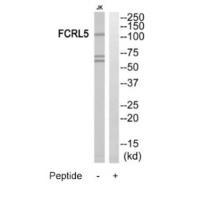
| WB | 咨询技术 | Human,Mouse,Rat |
| IF | 咨询技术 | Human,Mouse,Rat |
| IHC | 咨询技术 | Human,Mouse,Rat |
| ICC | 技术咨询 | Human,Mouse,Rat |
| FCM | 咨询技术 | Human,Mouse,Rat |
| Elisa | 咨询技术 | Human,Mouse,Rat |
| Aliases | Fc receptor-like protein 5; FcR-like protein 5; FcRL5; Fc receptor homolog 5; FcRH5 |
| Entrez GeneID | 83416; |
| WB Predicted band size | 107kDa |
| Host/Isotype | Rabbit IgG |
| Antibody Type | Primary antibody |
| Storage | Store at 4°C short term. Aliquot and store at -20°C long term. Avoid freeze/thaw cycles. |
| Species Reactivity | Human |
| Immunogen | Synthesized peptide derived from internal of human FCRL5. |
| Formulation | Purified antibody in PBS with 0.05% sodium azide. |
+ +
以下是3篇关于FCRL5抗体的代表性文献摘要:
---
1. **文献名称**:*FCRL5 delineates functionally impaired memory B cells associated with Plasmodium falciparum exposure*
**作者**:Sullivan, R.T. 等 (2015)
**摘要**:研究揭示了FCRL5作为疟疾流行区人群记忆B细胞的功能性标记物,利用FCRL5抗体检测发现其高表达与抗疟疾抗体产生能力下降相关,提示其在免疫调节中的作用。
---
2. **文献名称**:*FCRL5 is a marker of a pro-inflammatory B cell subset in chronic lymphocytic leukemia*
**作者**:Li, F.J. 等 (2019)
**摘要**:通过FCRL5抗体分析慢性淋巴细胞白血病(CLL)患者B细胞亚群,发现FCRL5+ B细胞具有促炎特性,且与疾病进展相关,为靶向治疗提供潜在靶点。
---
3. **文献名称**:*FCRL5 modulates BCR signaling and promotes survival in germinal center B cells*
**作者**:Ise, T. 等 (2017)
**摘要**:研究利用FCRL5抗体阻断实验,证实FCRL5通过调控BCR信号通路增强生发中心B细胞的存活,为自身免疫疾病和淋巴瘤机制研究提供新视角。
---
如需具体实验方法或扩展文献,可进一步说明研究方向(如癌症、感染免疫等)。
Fc receptor-like 5 (FCRL5), also known as FcRH5 or CD307. is a transmembrane protein belonging to the Fc receptor-like (FCRL) family. Unlike classical Fc receptors, FCRL5 lacks conserved binding motifs for immunoglobulin Fc regions but shares structural homology with them. It is predominantly expressed on the surface of mature B cells, particularly in subsets like germinal center B cells and plasma cells, where it regulates B cell activation, differentiation, and immune response modulation. FCRL5 contains immunoreceptor tyrosine-based inhibition motifs (ITIMs) and immunoreceptor tyrosine-based switch motifs (ITSMs), suggesting roles in both inhibitory and adaptive signaling pathways.
Antibodies targeting FCRL5 have gained attention in biomedical research and therapeutic development. In research, FCRL5-specific antibodies are used to study B cell biology, immune dysregulation in autoimmune diseases (e.g., lupus, rheumatoid arthritis), and malignancies like multiple myeloma, where FCRL5 is often overexpressed. Therapeutically, FCRL5 is explored as a target for antibody-drug conjugates (ADCs) or bispecific antibodies due to its restricted expression on malignant plasma cells, minimizing off-target effects. Recent clinical trials evaluate FCRL5-directed CAR-T cells and monoclonal antibodies for treating relapsed/refractory multiple myeloma. However, its complex signaling roles and variable expression across B cell populations necessitate further mechanistic studies to optimize targeting strategies.
×